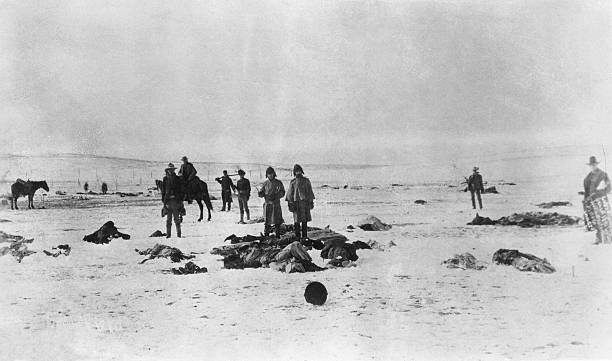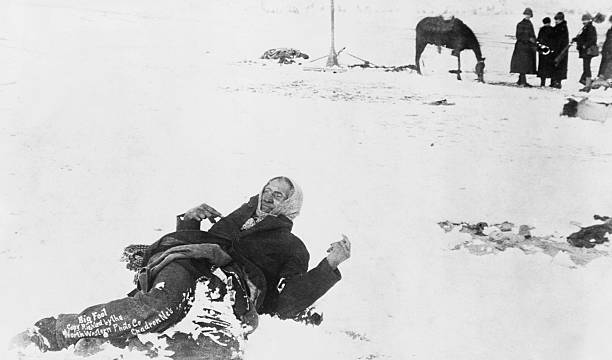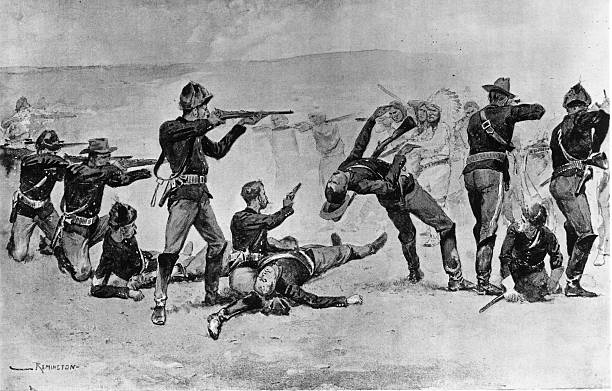The Dark Legacy of America: Recalling Wounded Knee Massacre
On December 29, 1890, a group of Lakota Sioux Indians was massacred by members of the U.S. Army’s 7th Cavalry Regiment near Wounded Knee Creek in South Dakota. The incident, which came to be known as the Wounded Knee Massacre, resulted in the deaths of more than 290 men, women, and children. The event marked a tragic culmination of years of conflict between the U.S. government and Native American tribes over land and resources.
Conflicts over Land and Resources
The late 19th century was a time of great change in the United States, as the country sought to expand westward and acquire more land. This often meant forcibly removing Native American tribes from their ancestral lands and confining them to reservations. The U.S. government also broke treaties and agreements with Native American tribes, often to exploit resources such as gold and timber on their lands.
The Lakota Sioux, along with other Native American tribes, resisted this encroachment on their lands and way of life. They engaged in armed conflict with the U.S. government and military in several battles, including the Battle of Little Bighorn in 1876, where Lakota Sioux and Cheyenne warriors defeated General George Custer and his troops.

Forced Assimilation and the Ghost Dance Movement
In the years leading up to the Wounded Knee Massacre, the U.S. government instituted a policy of forced assimilation, which sought to strip Native American children of their language, culture, and traditions by placing them in government-run boarding schools. Additionally, a religious movement known as the Ghost Dance had spread among Native American tribes, which some U.S. officials believed to be a prelude to an uprising.
The Ghost Dance movement, which originated among the Paiute tribe in Nevada, was based on the belief that a great spirit would come to rid the land of white settlers and restore the buffalo herds that had been decimated by overhunting. The movement spread rapidly among Native American tribes, including the Lakota Sioux.
The Wounded Knee Massacre: Events Leading up to the Tragedy
In response to the Ghost Dance movement, the U.S. government dispatched troops to the Pine Ridge Indian Reservation, where the Lakota Sioux were living. The troops were under the command of Colonel James W. Forsyth, who was tasked with disarming the Lakota Sioux.
On the morning of December 29, 1890, soldiers attempted to disarm a group of Lakota Sioux who had surrendered. A scuffle broke out, and a single shot was fired. In the chaos that followed, soldiers opened fire on the unarmed Lakota Sioux, killing men, women, and children.

Big Foot, leader of the Sioux, captured at the battle of Wounded Knee, South Dakota. Here he lies frozen on the snow-covered battlefied where he died. 1890.
Aftermath and Legacy – Wounded Knee Massacre
The Wounded Knee Massacre was a tragic event that had a profound impact on Native American communities and the broader American public. The massacre marked the end of armed resistance by Native American tribes against the U.S. government and military. It also served as a reminder of the injustices suffered by Native Americans at the hands of the U.S. government and military.
In the aftermath of the massacre, the U.S. government conducted an investigation and exonerated Colonel Forsyth and his troops of any wrongdoing. However, public outrage over the event led to calls for reform of government policies toward Native Americans.
Today, the Wounded Knee Massacre is recognized as a significant event in Native American history and is remembered as a tragic example of the violence and injustice inflicted upon Native American communities by the U.S. government and military. The site of the massacre has become a national historic landmark and a memorial to the victims.
Despite the recognition and remembrance of the Wounded Knee Massacre, the struggles of Native American communities continue to this day. Many tribes still face challenges related to poverty, healthcare, and education, among others. Additionally, the legacy of forced assimilation and the suppression of Native American cultures and traditions persists in many ways.
Efforts have been made to address some of these issues, such as the passage of the Indian Child Welfare Act in 1978, which seeks to protect Native American children and families from being separated and assimilated into non-Native households. However, there is still much work to be done to address the ongoing struggles and injustices faced by Native American communities.
Legacy and Lessons
The Wounded Knee Massacre is a tragic chapter in Native American history that serves as a reminder of the injustices and violence inflicted upon Native American communities by the U.S. government and military. It also highlights the ongoing struggles faced by Native American communities today, including issues related to poverty, healthcare, and education.
As we remember the victims of the Wounded Knee Massacre and honor their memory, we must also work towards addressing the ongoing challenges faced by Native American communities and strive for a more just and equitable society for all.
Here are some frequently asked questions about the Wounded Knee Massacre and their answers:
Q: How did the Wounded Knee Massacre start?
A: The Wounded Knee Massacre started when the U.S. Army’s 7th Cavalry Regiment surrounded a group of Lakota Sioux Indians who had surrendered and were in the process of being disarmed. A shot was fired, and chaos ensued, resulting in the massacre of more than 290 men, women, and children.
Q: What was the cause of the Wounded Knee Massacre?
A: The Wounded Knee Massacre was a culmination of years of conflict between the U.S. government and Native American tribes over land and resources. The U.S. government had been attempting to forcibly assimilate Native Americans into white culture, and tensions between the two groups had been building for decades.
Q: How many people died in the Wounded Knee Massacre?
A: More than 290 men, women, and children were killed in the Wounded Knee Massacre.
Q: What was the aftermath of the Wounded Knee Massacre?
A: The aftermath of the Wounded Knee Massacre included the removal of Native American children from their families and placement in government-run boarding schools. The suppression of Native American cultures and traditions, and ongoing struggles faced by Native American communities, including issues related to poverty, healthcare, and education. The massacre also helped to spark a renewed interest in Native American rights and activism.

If any race of people deserve reparation , it is the Native Americans!
Trust the United States Government? Ask a Native American.
Why were the soldiers there? Does anything remind anyone of current events?